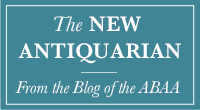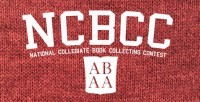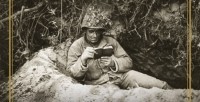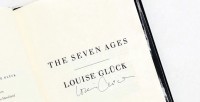Our members list new acquisitions and recently cataloged items almost every day of the year. Below, you'll find a few highlights from these recent additions... (The Beginning of the French Revolution) Le Courrier d'Avignon, No.58, Mercredi 22, Juillet 1789 (Wednesday July 22, 1789) La Bastille (Histoire Generale de Paris) by Aubanel, Antoine (ed.) Avignon, 1789. First edition. Loose leaf. Quarto. 9.5 x7.5". 237-240pp. . Text printed in black in a two-column format, with woodcut headpiece/decorative border surrounding the title at the top of the first page. Pages uncut, printed on rag paper. This remarkable document, an issue of the 18th century biweekly newspaper Le Courrier d'Avignon, was published just eight days after the storming of the Bastille (July 14th, 1789) and consists of the first uncensored journalistic account of the those events, the preceeding civil unrest, and the upheavals throughout the following week. These events are now seen to have marked the beginning of the French Revolution. A two-sided supplement leaf to issue #58 giving further details of the events, is also included. Do to the fact that Avignon was at this time still a Papal enclave, not under control of the French monarchy, the press there was not under same censorship to which all other French press at the time was subject ("privilege with permission"), allowing the accounts of these events to be given in unadulterated direct detail. Pages 239-240 relate in gruesome detail, the events of July 14... [more Weekly Highlights]
On Collecting Books
The ABAA is accepting entries for the 2025 National Collegiate Book Collecting Contest where more than $6,000 in prizes will be awarded to student collectors. The contest is open to all prizewinners of college contests, whether or not first prize, and to interested students whose institutions do not offer contests. More information can be found here... All entries should be submitted here by June 9, 2025. The National Collegiate Book Collecting Contest is jointly administered by the Antiquarian Booksellers' Association of America (ABAA), the Fellowship of American Bibliophilic Societies (FABS), the Grolier Club, and the Center for the Book and the Rare Books and Special Collections Division of the Library of Congress. For more information on the contest, please visit contest.abaa.org. Read more about last year's winners here... [more 2025 National Collegiate Book Collecting Contest]
The 2025 winner of the California Young Book Collector's Prize is Kierra Duncan. Kierra is 27 years old. She was raised in the Los Angeles area and graduated from UCLA summa cum laude in English and current doctoral candidate at Princeton University. Duncan's collection, “Translating Blackness Across Space: American, British, and Caribbean Editions of 20th Century Black Literature.” wowed the judges with her collection Translating Blackness Across Space: American, British, and Caribbean Editions of 20th-Century Black Literature. Duncan brought together works by Toni Morrison, V.S. Reid, Gayl Jones, George Lamming, Eric Walrond, and Sylvia Wynter to chronicle and analyze manifestations of Black identity in anglophone literature and publishing. Along with collecting the work of iconic twentieth-century Black writers, Duncan examined book design, marketing, and other paratext to gain insight into how publishers communicated Black stories when selling books to new national audiences. Duncan wrote that her collection was "driven by two needs. First, the urge to figure out what that sticky, elusive something is that made Black inaccessible when published in another English speaking nation. Second, to identify the (un)conscious methods deployed by publishers to address this problem before the reader even began the book. I remain guided by a question: What alterations were made to a literary text in order to make it accessible to other English speaking nations? To explore this qu... [more 2025 Annual California Young Book Collector’s Prize Awarded]
The ABAA Diversity Initiative is proud to announce the first season of a guided program for individuals seeking to pursue a career in the antiquarian and rare book trade. Designed to co-occur with annual ABAA book fairs, the program offers an introduction to antiquarian book fairs, career insight with ABAA members, visits to local ABAA member open shops/offices, networking with institution professionals, and more. This Diversity Discovery Program offers stipends of up to $2,500 to two individuals to visit the Boston International Antiquarian Book Fair during the week of the fair. Participants will be guided by an ABAA member and with an itinerary of multiple networking activities. The Fall 2024 ABAA Diversity Initiative Discovery Program selected Julie Browny and Patrick Matherly as recipients. The program successfully concluded on November 7th, 2024. Want to get to know Julie and Patrick and their program journey? Read their blog below! Read Julie Browny's blog here... Read Patrick Matherly's blog here... The program would like to thank the following libraries, private collectors, and ABAA firms for hosting the participants. John A. Buchtel, Lauren Graves, BOSTON ATHENÆUM John Overholt, Molly Schwartzburg, Mathew Wittmann, Houghton Library Victor Betts, Jenny Gotwals, Patrice Green, Schlesinger Library Alexandra (Allie) Alvis, Winterthur Museum, Garden & Library Lisa Baskin Alan Klein Sandy Neubauer Brattle Book Shop Bernett Rare Books Bromer Booksellers The program would ... [more 2024 ABAA Discovery Program Participant Experience]
Armed Services Editions, small-format paperback books distributed to US servicemen during WWII, are credited with achieving a great deal: not just with improving morale among the troops, but also with revolutionizing the post-war publishing industry, making certain books into classics, and expanding the American middle class. The book When Books Went to War: The Stories That Helped Us Win WWII, by Molly Guptill Manning, reveals the largely forgotten story of the Armed Services Editions. When the US entered the war after Pearl Harbor, librarians initially got behind a nationwide book drive, the Victory Book Campaign, which aimed to collect 10 million donated books and supply them to the troops. Although this campaign was eventually successful, it took time, and many of the donated books were too old or heavy to be of use. A group of publishers came together to form the Council on Books in Wartime, and resolved to produce a series of lightweight, durable books which reprinted popular novels and classics that would be of interest to the soldiers, sailors, and airmen serving their country. The format was innovative: paperback, stapled (later glued) on the short side, and printed in small type across two columns to fit more words on a page and make reading under battlefield conditions easier. The covers were thumbnails of the original hardcover jacket image, and carried lists of the other ASE titles released that month. The books were initially printed in two sizes, both designed ... [more Collecting Armed Services Editions]
As the current president of the ABAA, I have been attending the biannual Congress of the International League of Antiquarian Booksellers (ILAB), the umbrella organization that brings together national Associations from around the world. Our hosts in Amsterdam have outdone themselves! The main Congress was preceded by meetings to discuss official ILAB business. The protection of cultural property, while pursued for the noblest of reasons, can lead to incredible bureaucratic burdens and even become counterproductive if people familiar with the actual function of the book trade aren't involved in shaping policy. Fortunately, ILAB's Executive Secretary Angelika Elstner has been elected to the European Union's Art Market Expert Group to provide precisely this kind of input. Among other contributions, ILAB has shown that Interpol's figures for stolen library materials were wildly exaggerated. For example, it claimed that 472,933 pieces of “Library material” had been seized in the past year, which, if true, would mean that the book trade was awash in literal mountains of stolen goods. ILAB was able to show that almost the entire figure derived from a single 500-year-old family archive in Italy that was confiscated by the state as part of a dispute over legal ownership. In point of fact, ILAB and its affiliates are always eager to protect the integrity of institutional collections, and now ILAB has a voice in the European Union to help shape policies that sustain this goal withou... [more ILAB Congress in Amsterdam: Business and Pleasure]
The CABS-Minnesota Antiquarian Book Seminar celebrated its 48th year this July on the campus of St. Olaf College. The class of over 50 convened for an intensive week of hands-on instruction and informal conversations about the book trade, including impromptu book shops in the dorms and a lecture from specialty dealer Alexander Akin of Bolerium Books. 22 of the students were supported by scholarships, including from the ABAA Woodburn Fund. Find out more at www.bookseminars.com. [more 2024 CABS-Minnesota Antiquarian Book Seminar]
Jeff Weber is proprietor of Jeff Weber Rare Books, Montreux and Neuchâtel, Switzerland. He is a member of ILAB, ABAA and VEBBUKU/SLACES (Switzerland). What, by its nature, would be rarer than an original Gutenberg Bible? The invoice that recorded the sale of the first books printed with moveable type! The receipt! Yes, those most-often tossed slips of paper, recording a seemingly trivial event, those receipts are golden to the researcher today if receipts would be appreciated. The receipt will never be as valuable as the item itself, but the tossed data is where the story of how a book (or another item) was distributed, who was involved, and when. When that receipt is tossed, its recorded history is lost, perhaps never to be recognized again. The purpose of writing about receipts is to make the point that there is scholarly value in saved receipts, particularly when they unlock the mysterious ties between buyer and seller. I will refer to a number of personal projects that have benefitted from saved receipts or would have benefitted more had those receipts been kept. By some pertinent examples, I hope that the reader will consider the value of using receipts in their research. This, by my purpose, is to encourage institutions and collectors as well as those who inherit personal papers, to keep notes, receipts, email archives, manuscripts, all kinds of primary research data that can be used in the future to understand more by using those receipts and other materials, to advan... [more Book Receipts: Ephemera with Essential Intellectual Value]
What's better: a simple author signature, or an inscription? As a longtime bookseller -- a veteran of Borders, Waldenbooks, and independent bookstores -- I thought I knew the answer. But, once I began working for antiquarian booksellers, I discovered the question is much more complex. A comment on the ABAA Facebook page recently asked why some booksellers appear to prefer plain signed books, rather than inscribed ones? While trying to find the answer, I encountered an interesting tale of changing fashions and the dark side of book collecting. The prevailing wisdom in literary circles over the past decade or two has been to ask an author for a plain signature when getting a book autographed (some collectors even purchase two copies, asking the author to inscribe one to them for their 'permanent collection,' and to simply sign their name to the other one, which they will hold onto in the hopes its value appreciates -- sellers of new books have no qualms about endorsing this point of view, although antiquarian booksellers know there is no certainty of modern firsts becoming valuable collectibles, and strongly caution collectors against viewing them as such). To my shame, I've organized and helped run hundreds of book signings and never previously gave this standard advice much thought. inscribed -- a book, or other printed piece, with a handwritten and signed statement usually written for a specific named person(s) and often located on the end paper or title page; when "inscribe... [more Signed Books Vs. Inscribed Books]
The Booksellers Documentary producers Dan Wechsler (Sanctuary Books), D.W. Young, and Judith Mizrachy recently premiered UNCROPPED, which rediscovers the work of James Hamilton, one of the great photographers of the cultural history of America. For over four decades working on staff at publications such as Harper's Bazaar, The New York Observer, and most notably, The Village Voice, Hamilton captured remarkable people and stories of the last half-century. Hamilton chronicled the punk and jazz music scene in 1970s and 80s New York City, creating iconic images of musicians like Charles Mingus, Patti Smith, and Lou Reed and taking intimate portraits of everyone from Akira Kurosawa and Jean-Luc Godard. He eventually broke off to do set photography for George Romero, Noah Baumbach, and Wes Anderson. He pursued controversial assignments across the U.S. and the world, which, at times, reveal its seedy underbelly. He never stopped amassing a stunning visual love letter to New York City in all its grit and glory. Hamilton's story and vast archive offer a singular window into the heyday of alternative print media. Taking its name from Hamiton's assertions that publications never cropped his images, Uncropped's filmmakers detail Hamilton's process and his uncanny ability to know the precise moment to unfold a vignette in just two colors. Among the most poignant works are his sympathetic photos of drug-addicted sex workers in pre-gentrified Williamsburg, a young Patti Smith with Tom Verl... [more Booksellers Documentary Producers Premiere UNCROPPED]










